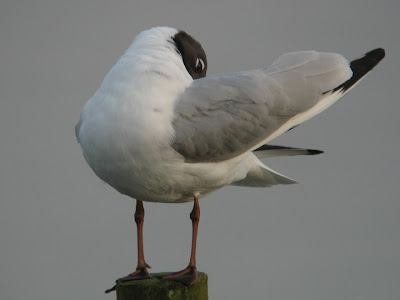Not a day for pictures, but still a day with a good few birds to report. First thing I was surprised not to see any Sand Martins over Ibsley Water, in fact a single
Black-necked Grebe was the only thing of note, I wish I had realised that his was by far the best part of the day.
Around the Centre and Woodland areas it was clear there had been an arrival of
Lesser Redpoll and probably
Siskin,
Brambling were also more in evidence. The Redpoll were especially noticeable as there have been almost none since the start of the month, I would estimate at least forty today.
The mild night had produced a good haul of moths with
Yellow-horned the most numerous others were
Oak Beauty,
Chestnut,
Twin-spot Quaker,
Small Quaker,
Common Quaker,
Small Brindled Beauty and
Hebrew Character, by far the best night of the year so far. No pictures as the drizzle was increasing.
The drizzle turned to rain, so office-bound for the rest of the morning sorting count data. Decided to lunch in the Tern hide, good move, there were at least 100
Sand Martins over the lake, my first real flock of the spring. I had hoped for a Swallow but no luck, there was a calling
Little Ringed Plover somewhere east of the hide but I could not find it. Two
Grey Wagtails were with the Pieds but I could not find the Water Pipit from the other day, so perhaps it has moved on.
In the afternoon I got very wet cleaning bird feeders, they need a good wash-out and I try to keep one in for cleaning all the time so that they can be rotated and kept hygienic, I had got a bit behind so I had two nyger and two seed feeders to do. One of the nyger feeders had been damaged by
Grey Squirrel so I modified it by cutting off the bottom section. A heavy perch had been placed too close to the feeder, within jumping range, no doubt by an over enthusiastic photographer (the jumping done by the squirrel, not the photographer!).
By the end of the day there had been 12mm of rain and it was still falling, miserable, I hope tomorrow is better.
 Above the male calling, the throat expanded and below making a scrape.
Above the male calling, the throat expanded and below making a scrape. Other birds today included a Wheatear, the first if the year, a Peregrine and about 50 Black-tailed Godwit.
Other birds today included a Wheatear, the first if the year, a Peregrine and about 50 Black-tailed Godwit. 









 Also from this hide I saw the 4 Black-necked Grebe and about 40 Black-tailed Godwit.
Also from this hide I saw the 4 Black-necked Grebe and about 40 Black-tailed Godwit.























 The amount of bird song is really increasing as well, by the Centre several Robins were singing away and there were also Treecreepers, Chaffinches, Great Tits and others getting in on the act with a time beaten by at least three drumming Great Spotted Woodpeckers.
The amount of bird song is really increasing as well, by the Centre several Robins were singing away and there were also Treecreepers, Chaffinches, Great Tits and others getting in on the act with a time beaten by at least three drumming Great Spotted Woodpeckers.








